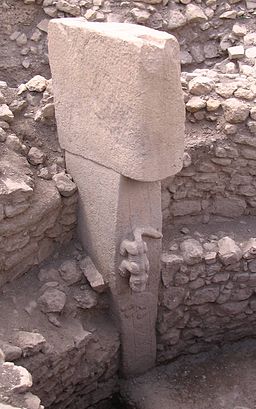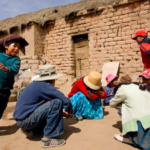
Human Nature and the Temple at the Dawn of Time: Gobekli Tepe
 In the last twenty or so years archeologists have excavated a temple that was built so long ago that no human being had yet thought of planting a crop. It was built so long ago that only stones and bones were used to create it and the many works of art that adorn it. The temple was built before the wheel, before animal husbandry and before the creation of pottery. It precedes large scale government. It precedes the invention of armies, cities and empires. It was created by people who hunted and gathered to collect their food. The temple’s scale forces us to rethink everything we thought we knew about the people of those times and the geographic scales on which they interacted with each other. More, it forces us to rethink what we thought we knew about ourselves. This place is known as Gobekli Tepe. Its oldest layers were built about 11,000 years ago.
In the last twenty or so years archeologists have excavated a temple that was built so long ago that no human being had yet thought of planting a crop. It was built so long ago that only stones and bones were used to create it and the many works of art that adorn it. The temple was built before the wheel, before animal husbandry and before the creation of pottery. It precedes large scale government. It precedes the invention of armies, cities and empires. It was created by people who hunted and gathered to collect their food. The temple’s scale forces us to rethink everything we thought we knew about the people of those times and the geographic scales on which they interacted with each other. More, it forces us to rethink what we thought we knew about ourselves. This place is known as Gobekli Tepe. Its oldest layers were built about 11,000 years ago.

What the temple and other archeological findings associated with it suggest, is that religion was the organising principle that provided the catalyst for the agricultural revolution and hence of the unfoldment of civilization that followed. Only 30 kilometres from where this temple was built we find the later origin of the oldest varieties of domesticated wheat.
In Seven Heavens and Extrasolar Planets we saw an example of statements made by Baha’u’llah, subsequently being confirmed by science. This is a similar instance – specifically Baha’u’llah’s statements that suggest that religion is the source of civilization. Thus, in respect of the influence Jesus had on subsequent human development, Baha’u’llah states:
The deepest wisdom which the sages have uttered, the profoundest learning which any mind hath unfolded, the arts which the ablest hands have produced, the influence exerted by the most potent of rulers, are but manifestations of the quickening power released by His transcendent, His all-pervasive, and resplendent Spirit.[1]
In another passage concerning religion more broadly Baha’u’llah states:
The religion of God and His divine law are the most potent instruments and the surest of all means for the dawning of the light of unity amongst men. The progress of the world, the development of nations, the tranquility of peoples, and the peace of all who dwell on earth are among the principles and ordinances of God. Religion bestoweth upon man the most precious of all gifts, offereth the cup of prosperity, imparteth eternal life, and showereth imperishable benefits upon mankind.[2]
We have also already seen that Baha’u’llah affirmed the existence of prophets (and therefore religious systems) before the era of writing.
The connection between civilization, knowledge and religion throughout recorded history is hard to ignore, if we put aside the false dichotomy between science and religion that tends to dominate thinking in our own times. To take a small example we may think of the civilizing influence of Buddhist monks in the islands of Japan in the East who inspired warlords to create gardens; or we may think of the influence of Augustine Christian monks in the islands of Britain in the West, who inspired not so different Anglo-Saxon warlords in the arts of writing and law.
Gobekli Tepe has other implications about human nature. It precedes, by thousands of years, all evidence of the kinds of warlords to which we have just referred. The temple is decorated with the natural world its builders knew. While it does not exclude the existence of small scale human conflict, it is clear that such conflict is marginal to the lives of those who came together in this place and catalysed the neolithic revolution. The people who built this temple did not organise armies. They organised festivals.
We may think of many ancient structures where this is not true: where war is far more central. We may think of the thick defences of the ancient city of Mycenae, or the celebration of war in the monuments of ancient Egypt or Assyria, who were most definitely warlike. Yet we now know that such places were not the original model, they emerged later. They came after civilization started.
Gobekli Tepe is not the only locus of civilization that lacks the marks of endemic warfare. The Minoan civilization is also associated with celebration of the natural world – and marginal (although some) evidence of preparation for war. The most ancient cities of South America, the Norte Chico civilization that dates to 3500BC lacks all marks of warfare. No military murals, no defences of any kind, no evidence of destructive warfare. Such civilizations existed for hundreds, sometimes thousands of years before evidence of warfare emerges. We may also note the neolithic Stonehenge in Britain, that is now known to have been a centre of worship for the entire island – part of a widespread unified culture that spanned Britain. We need only one such place to show that warfare is superfluous to human progress and that it is not inherent to human social organization. We have numerous such places.
Gobekli Tepe came before them all. At the dawn of time, when hunter gatherers came together, and sparked the agricultural revolution in the Near East, they did so in orientation to the sacred.
For the International Year of Peace, the Universal House of Justice issued a statement on peace. On human nature they stated:
… so much have aggression and conflict come to characterize our social, economic and religious systems, that many have succumbed to the view that such behavior is intrinsic to human nature and therefore ineradicable.
With the entrenchment of this view, a paralyzing contradiction has developed in human affairs. On the one hand, people of all nations proclaim not only their readiness but their longing for peace and harmony, for an end to the harrowing apprehensions tormenting their daily lives. On the other, uncritical assent is given to the proposition that human beings are incorrigibly selfish and aggressive and thus incapable of erecting a social system at once progressive and peaceful, dynamic and harmonious, a system giving free play to individual creativity and initiative but based on cooperation and reciprocity.
As the need for peace becomes more urgent, this fundamental contradiction, which hinders its realization, demands a reassessment of the assumptions upon which the commonly held view of mankind’s historical predicament is based. Dispassionately examined, the evidence reveals that such conduct, far from expressing man’s true self, represents a distortion of the human spirit. Satisfaction on this point will enable all people to set in motion constructive social forces which, because they are consistent with human nature, will encourage harmony and cooperation instead of war and conflict.[3]
Articles about Gobekli Tepe:
Gobekli Tepe: The World’s First Temple? Smithsonian
Gobekli Tepe: The Birth of Religion National Geographic
Oliver Dietrich et al., The Role of Cult and Feasting in the Emergence of Neolithic Communities. New Evidence from Gobekli Tepe
Klaus Schmidt, Göbekli Tepe – the Stone Age Sanctuaries. New results of ongoing excavations with a special focus on sculptures and high reliefs
E. B. Banning, So Fair a House Gobekli Tepe and the Identification of Temples in the Pre-Pottery Neolithic of the Near East
Reindeer Neef, Overlooking the Steppe-Forest: A Preliminary Report on the Botanical Remains from Early Neolithic Göbekli Tepe (Southeastern Turkey)
Image Credits:
Gobekli Tepe By Teomancimit (Own work) [CC BY-SA 3.0 (http://creativecommons.org/licenses/by-sa/3.0)], via Wikimedia Commons
Animal Sculpture at Gobekli Tepe
(This article is the 117th in a series of what I hope will be 200 articles in 200 days for the 200th anniversary of the birth of Bahá’u’lláh. The anniversary is being celebrated around the world on 21 and 22 October 2017, The articles are simply my personal reflections on Bahá’u’lláh’s life and work. Any errors or inadequacies in these articles are solely my responsibility.)






